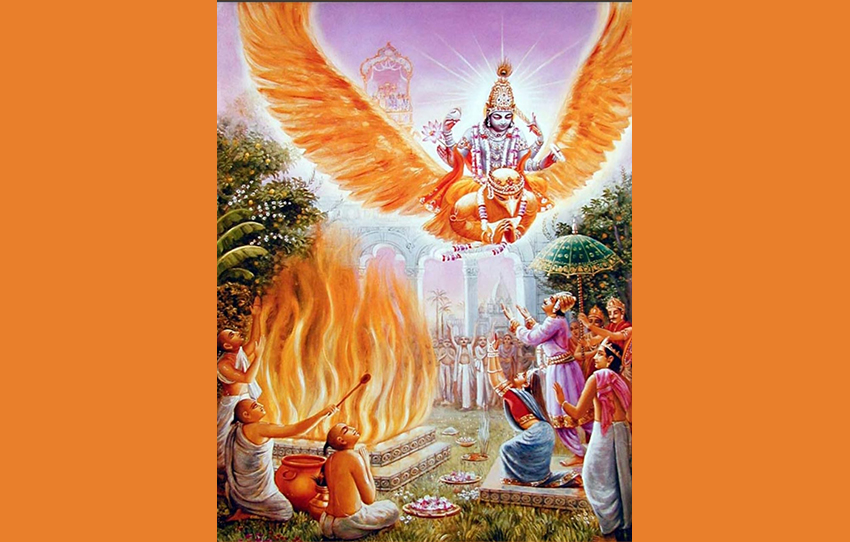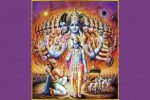Name 3
Vaṣaṭkāraḥ वषट्कारः
But, why Viṣṇu is being called Vaṣaṭkāraḥ? Yajur Veda (I.vii.4) answers this question. It says, “By sacrifice to Viṣṇu, by the sacrifice may I attain health, wealth and security as Viṣṇu is yajna and certainly the sacrifice finds support at the end.” The original mantra goes like this:
Vaṣaṭ is an exclamation used in sacrificial fire rituals. At the time of reciting the last three syllables (ṣaṭ), offerings are poured into fire by the priest. Vauṣaṭ and Vaṣaṭ convey the same meaning and are used especially for the tranquillity and stability of oblations.
विष्णोः शंयोरहं देवयज्यया यज्ञेन प्रतिष्ठां गमेयमित्याह यज्ञोवै विष्णुर्यज्ञ एवान्ततः प्रतितिष्ठति।
viṣṇoḥ śaṁyorahaṁ devayajyayā yajñena pratiṣṭhāṁ gameyamityāha yajño vai viṣṇuryajña evāntataḥ pratitiṣṭhati |
Viṣṇu is the Lord for all fire sacrifices. Whatever the oblations are offered in the fire for Viṣṇu, reaches Him through the god of fire Agni, who is the carrier of all oblations to the concerned deities in the upper worlds.
Vedas also convey subtle interpretations. For example, what is being described as fire rituals should not be taken on their face value. Yajña means mental oblations that purify one’s mind to establish a perpetual connection with Lord Viṣṇu, who is the upholder of this universe. Evil thoughts and actions are burnt in the inner fire offering them as oblations. When evil impressions of the mind are burnt, what remains is an unaffiliated mind. Viṣṇu upholds the universe purely on virtuousness and slays all those who indulge in evil acts. This is the reason for Viṣṇu to incarnate again and again. When there is imbalance between virtuousness and evilness, He takes avatar to preserve virtuousness.
Subsequent nāmas discuss more on this aspect.
३ .ॐ वश्ष्टकाराय नमः
3. Om Vashatkaarah Namah
ln the ritualistic portion of the Vedas we find many mantras ending with ‘vashat’ and they are used in pouring devoted and dedicated oblations. Thus the term Vashatkaara means: He who is invoked, and for propitiating whom, the oblations are poured in Vedic ritualism, using mantras ending with vashat.
Also Vashatkaara can mean yajna in its association and thus the term in its suggestion can signify ‘He who is of the form of the Yajna’. In the Upanishads also we find this meaning endorsed when the Upanishad mantra says: “YajnovaiVishnuh” – Yajna itself is Vishnu.
INTERPRETATION GUIDED BY SANT VANI (WORDS OF SAINTS)
VASATKARAH
The one invoked through vaṣat. वषट्कारः vaSaTkAraH – The Deity invoked through वषट् through a fire sacrfice.
Vaṣaṭ is a purely technical word used in the fire rituals. ‘Kāra’ is the pratyaya, the suffix, that is added to ‘vaṣaṭ.’ In a yajña, fire ritual, an oblation is offered unto the fire to a particular deity, with a mantra and the ritual itself is done for a particular purpose. Generally, the oblation is offered saying ‘svāhā’ or ‘vaṣaṭ,’ followed by ‘idamna mama,’ this is no more mine.
Yaduddeśenaadhvarevaṣaṭ kriyatesavaṣaṭtkāraḥ – that deity to whom the oblation is offered by saying ‘vaṣaṭ,’ is called vaṣaṭkāra. All these deities are nothing but Parameśvara. It can be a particular devatā such as Indra the deity of strength, Agni the deity of speech, Soma the deity of the mind, Brhaspati the deity of intellect, Varuṇa the deity of water and so on.
Where is the individual jīva? In which part of the physical body does he exist? The individual is all over the body, all-pervasive. When the little finger of the person is touched, it is not that only a part of the person is touched, but the complete attention of the person is drawn to the little finger. So too, every devatā is Parameśvara, because He is viśva. Therefore, vaṣaṭkara, the deity invoked with a ‘vaṣaṭ,’ is Parameśvara alone.
Even though the oblation is offered only to a particular devatā, and it no doubt goes into the fire, still, it finally goes only to Parameśvara alone. Just as all the water that comes from the sky ultimately goes to the ocean through the rivers, similarly, all salutations go to Bhagavān. If this is the case with even the devatās, then the human beings, who receive namaskāras, must act as conduits and direct all the namaskārastoBhagavān.
Yasmin yajñevaṣaṭkriyā–in which yajña an offering is done with the mantra ‘vaṣaṭ,’ that also is Viṣhṇu alone, because yajñovaiviṣṇuḥ. The connection between the karma and the karmaphala is governed by an order. That order is Parameśvara.
If we rely on perception then there seems to be no connection between the karma, the fire ritual and the result which is heaven. In between, there is something called puṇya that is generated. That puṇya has to be exchanged for the final result. It is something like the token coins given in the gambling houses. They are not real coins, but they have to be exchanged later for real money, when you go out. That connection between the sādhya, the enjoyable heaven or something else and the sādhana, the ritual, is brought about by the adrṣṭa-puṇya. So, the very yajna is Bhagavān, the result is Bhagavān, the connection is Bhagavān and the order by which the connection is brought about is also Bhagavān.
Śaṅkara quotes a sloka from the Viṣṇu-smrti: ‘May that Viṣṇu be pleased with me, the one who is worshipped with the four syllable ośrāvaya, again with the four syllabled astuśrauṣaṭ and then with the two syllabled yaja and the five syllable yeyajāmahe and again with the two syllabled vaṣaṭ.’
वषट् is a mantra which is uttered in a vedic fire sacrifice – Homa, while offering oblations. Similar to svAhA.
आकाशात् पतितं तोयं यथा गच्छति सागरम् | सर्वदेवनमस्कार: केशवं प्रति गच्छति ||
Just as waters from the skies in the form of rain form – springs, streams, rivers and finally merge into the ocean. Like the Ganga starts in Gomukh in Himalayas and finally merges into Ganga-saagaram in Bay of Bengal, so too in this जीवयात्रा( journey of life) all the prayers and prostrations to any deity, in any form, reach the supreme पुरुषः alone, the One extolled by the Vedas. Each ishta devata is a standpoint , a point of view. Hence वषट्कारः devata is BhagavAn here.
The shruti also say – The sacrifice indeed is विष्णुः so a meaning of वषट्कारः is also यज्ञ, the sacrifice. ‘कार’ pratyaya or suffix when added to वषट् yields वषट्कारः
In Tantrokta_Ratri_Suktam[1] recited in Devi Mahatmyam by Brahmaji to wake up Lord Viṣhṇu from His Yoga Nidra (who is none other than the Devi) and kill Madhu and Kaitabh it is mentioned as:
तन्त्रोक्तंरात्रिसूक्तं –
त्वंस्वाहात्वंस्वधात्वंहिवषट्कारःस्वरात्मिका
TantroktaRatriSuktam – TvamSwahaTvamSwadhaTvam Hi VasatkarahSvaratmika
The first two names Viswam and Vishnu referred to
(1) he who is the ‘Universal-All’ and
(2) “he who is everywhere” i.e Vishnu.
The third name is “VASHATKARAHA”
This is an interesting name and there are at least two different ways in which the name is interpreted – there could be more, but lets discuss the two interpretations here. The first one is the standard interpretation and the second a very innovative take on the name.
(1) Vashatkaraha is he who is the receiver of all that is offered in the Yajna and in whose name the oblation is offered to Agni. From names one and two (Viswam and Vishnu) we can also conclude that he is not only the receiver but also the doer and the yajna itself, all that is offered and the consumer of the offering (Agni) as well.
This is confirmed by:
“Yajno Vai Vishnuhu (Tait Sam 1.7.4)
“The yajna itself is Vishnu”
As receiver he is Agni swaroopa, the divine messenger as well as the “Sakshi” the eternal witness, who is with us at every milestone of life from birth to death forever witnessing our every act as agni in the homam, as the flame in the lamp, as the firewood and fire in the kitchen and as the digestive power in the digestive organs.
Even in the Sandhyavandanam Vishnu is worshipped as the Shakti dwelling in the Sun during the day and the Shakti dwelling in Agni at night.
The second interpretation is as below:
(2) Vashatkaraha can be split into the following:
- Va meaning “this”
- Shat meaning six
- Kara meaning “one who is known as”
- He who guides every living being through the six states of life: (a) Jaayate (birth) (b) Asti (existence/living) (c) Vardhate (growth) (d) Parinaamate (change/age) (e) Apaksheeyate (decay and disease) (f) Mriyate (death)
And as the eternal witness he is also the silent observer of each living being in each of these six stages (including what they do in each moment)
[1]: ( Tantrokt Ratri Suktam )



